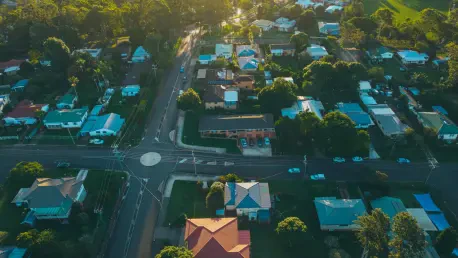The escalating threat of natural disasters hovering over Australian properties has ignited concerns over skyrocketing insurance costs and the potential uninsurability of homes across the nation. With the frequency and intensity of these events continuing to rise, insights from the Climate Council have highlighted the precarious situation facing over two million homes vulnerable to the impacts of bushfires, floods, cyclones, and coastal erosion. As these calamities intensify, affected property owners find themselves grappling with the financial burdens imposed by these risks, threatening their ability to secure affordable insurance coverage. The narrative unfolding across Australia reflects a harsh reality as the intersection between climate change and economic viability becomes increasingly evident.
Regions of Vulnerability
New South Wales (NSW) leads the nation in regional vulnerability to natural disasters, particularly in areas susceptible to floods and fires. Richmond, an electorate within NSW, has been flagged as the most at-risk constituency, with nearly one-third of its properties falling into categories exposed to devastating bushfires or relentless flooding. This concerning trend is mirrored in Queensland, notably around Brisbane’s coastal zones plagued by inundation threats stemming from the Brisbane River. These alarming risk factors not only jeopardize infrastructure but also heighten economic strains due to increasing insurance premiums. While NSW bears the brunt of these climate-related calamities, other states are also grappling with their own set of challenges, highlighting a nationwide predicament that demands urgent attention and action.
Threats Across States
Beyond the borders of New South Wales, states such as Victoria and South Australia are confronting formidable challenges as well, with bushfires, floods, and high winds wreaking havoc in various electorates. The relentless march of climate change has fostered a landscape where regional vulnerabilities differ but are universally felt. As the frequency and unpredictability of these natural disasters climb, the imperative for climate action resonates louder than ever. Experts underscore the importance of addressing these threats systematically, where tailored interventions could mitigate potential devastation. Innovative strategies and policy frameworks are urgently needed to safeguard communities and ensure the long-term sustainability of affected areas, rather than relying on fragmented or reactive measures.
Call for Climate Action
Given the increasing exposure to extreme weather events across Australia, the necessity for governmental policy shifts and robust interventions has become paramount. Proposals are advocating for mechanisms such as flood levies, buyback initiatives, and design modifications for disaster-prone homes, aiming to foster resilience amid looming threats. The overarching goal remains clear—mitigating risks through comprehensive planning and safeguards. This call for action involves collaboration across various sectors, engaging local communities, policymakers, and insurance companies in creating a cohesive action plan. Strategic planning in vulnerable regions must anticipate future risks, while forward-thinking development supports a sustainable and disaster-resilient built environment.
Insurance Industry Response
As Australia finds itself on the brink of widespread insurance challenges, the Insurance Council of Australia is urging firms to respond by providing solutions like premium discounts for homeowners who undertake modifications to enhance disaster resilience. This move seeks to alleviate some of the financial pressure on property owners while promoting proactive measures to reduce susceptibility to catastrophic events. Furthermore, discussions around the removal of insurance taxes are gaining traction as another avenue to ease the burden. These collaborative efforts exhibit an understanding within the industry of the vital role it plays in maintaining affordability and accessibility to insurance coverage, essential to protecting homes and livelihoods across vulnerable areas.
Economists’ Perspectives
Economics specialists like Nicki Hutley and Karl Mallon are highlighting a nascent urgency surrounding the growing number of homes at critical risk of becoming uninhabitable due to escalating insurance costs and building expenses. Their discourse points to the disproportionate impact felt by economically disadvantaged regions where financial insecurity is compounded by the increasing costs of maintaining insurability. This situation not only threatens individual property owners but also poses broader socioeconomic implications, emphasizing the need for inclusive and equitable solutions to mitigate these financial burdens. The insightful analysis by various economic experts further delineates the challenges faced by local communities, underscoring the necessity for comprehensive strategies that account for the multifaceted nature of climate-related impacts.
Alarming Findings
Current assessments reveal that approximately 652,000 properties across Australia are classified as high-risk, facing significant challenges in obtaining affordable insurance. The Climate Council’s analysis forecasts an alarming trajectory potentially culminating in widespread uninsurability for many homes if strategies to address climate change are not implemented swiftly. As projections extend into the future, the severity of uninsurability risks could lead to heightened economic strain and decreased real estate values within affected regions. Concerted efforts are required to curb this relentless path, with proactive measures essential to safeguard communities from the daunting prospect of losing insurability altogether.
Real Estate Market Impact
In highly vulnerable areas such as Richmond, NSW, the ripple effects of climate-related threats are profoundly influencing the real estate market. Home prices in these regions are witnessing stagnation or decline as potential buyers and investors increasingly weigh climate risk factors into their decision-making processes. These trends exhibit an evolving market where environmental considerations are increasingly integral to the calculus of property value assessments. The impact is disparate across communities, where proactive mitigation strategies can buffer against immediate devaluation, offering a glimmer of hope for affected regions. Nevertheless, the need for robust reporting on climate risks remains critical to fostering transparency that empowers informed decisions in the housing sector.
Importance of Climate Reporting
Economist Eleanor Creagh emphasizes the vital role of standardized climate risk reporting in guiding homebuyers and shaping informed real estate choices amid escalating threats. Integrating climate considerations into real estate planning not only provides transparency but fosters accountability in decision-making, helping buyers navigate the complex landscape of climate vulnerabilities. Such standardization would embed an insightful understanding into purchasing processes, offering data-driven insights and enhancing risk awareness. As climate change persists, embedding these metrics into the real estate sector becomes essential to ensuring adaptive strategies, empowering prospective buyers while supporting climate resilience.
Policy and Prevention Strategies
Addressing uninsurability risks through strategic investments remains a focal point in tackling future scenarios. Suggested efforts include substantial funding directed toward flood defenses—levees, dams, and other infrastructure—supported by zoning enhancements, building regulations, and planning guidelines. Focused strategies should aim at reducing exposure within bushfire-prone areas, providing a holistic framework that transcends temporary fixes. Integrating climate considerations into public policy must align with broader climate initiatives, reflecting adaptability and readiness to confront impending challenges head-on. Such forward-thinking measures are vital in establishing resilient communities that can withstand the disruptive impacts of natural disasters.
Focus on Future Projections
As Australia faces significant insurance challenges, the Insurance Council of Australia is calling upon companies to devise strategies like offering premium discounts to homeowners who complete modifications aimed at boosting resilience against disasters. This initiative is designed to ease financial strain on property owners and simultaneously encourage proactive actions to decrease vulnerability to catastrophic occurrences. Alongside this, conversations about abolishing insurance taxes are gaining momentum as an alternative approach to further alleviate burdens. These collective endeavors demonstrate the industry’s awareness of its crucial role in ensuring insurance coverage remains affordable and accessible, which is vital for safeguarding homes and livelihoods in areas at risk. By incentivizing homeowners to bolster their property’s resilience and reconsidering fiscal policies related to insurance, the industry is striving to create a more sustainable and secure future for Australians living in the most susceptible regions.









